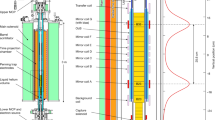Abstract
Special relativity asserts that physical phenomena appear the same to all unaccelerated observers. This is called Lorentz symmetry and relates long wavelengths to short ones: if the symmetry is exact it implies that space-time must look the same at all length scales. Several approaches to quantum gravity, however, suggest that there may be a microscopic structure of space-time that leads to a violation of Lorentz symmetry. This might arise because of the discreteness1 or non-commutivity2 of space-time, or through the action of extra dimensions3. Here we determine a very strong constraint on a type of Lorentz violation that produces a maximum electron speed less than the speed of light. We use the observation of 100-MeV synchrotron radiation from the Crab nebula to improve the previous limit by a factor of 40 million, ruling out this type of Lorentz violation, and thereby providing an important constraint on theories of quantum gravity.
This is a preview of subscription content, access via your institution
Access options
Subscribe to this journal
Receive 51 print issues and online access
$199.00 per year
only $3.90 per issue
Buy this article
- Purchase on Springer Link
- Instant access to full article PDF
Prices may be subject to local taxes which are calculated during checkout
Similar content being viewed by others
References
Gambini, R. & Pullin, J. Nonstandard optics from quantum spacetime. Phys. Rev. D 59, 124021 (1999)
Carroll, S. M., Harvey, J. A., Kostelecky, V. A., Lane, C. D. & Okamoto, T. Noncommutative field theory and Lorentz violation. Phys. Rev. Lett. 87, 141601 (2001)
Burgess, C. P., Cline, J., Filotas, E., Matias, J. & Moore, G. D. Loop-generated bounds on changes to the graviton dispersion relation. J. High Energy Phys. 0203, 043 (2002)
Myers, R. C. & Pospelov, M. Experimental challenges for quantum gravity. Phys. Rev. Lett. 90, 211601 (2003)
Pavlopoulos, T. G. Breakdown of Lorentz invariance. Phys. Rev. 159, 1106–1110 (1967)
Amelino-Camelia, G. et al. Tests of quantum gravity from observations of gamma-ray bursts. Nature 393, 763–765 (1998)
Schaefer, B. Severe limits on variations of the speed of light with frequency. Phys. Rev. Lett. 82, 4964–4966 (1999)
Biller, S. D. et al. Limits to quantum gravity effects from observations of TeV flares in active galaxies. Phys. Rev. Lett. 83, 2108–2111 (1999)
Kaaret, P. Pulsar radiation and quantum gravity. Astron. Astrophys. 345, L32–L34 (1999)
Norris, J. P., Bonnell, J. T., Marani, G. F. & Scargle, J. D. GLAST, GRBs, and quantum gravity. Bull. Am. Astron. Soc. 31, 717 (1999)
Gleiser, R. J. & Kozameh, C. N. Astrophysical limits on quantum gravity motivated birefringence. Phys. Rev. D 64, 083007 (2001)
Gonzalez-Mestres, L. Cosmological implications of a possible class of particles able to travel faster than light. Nucl. Phys. Proc. Suppl. 48, 131–134 (1996)
Coleman, S. & Glashow, S. L. High-energy tests of Lorentz invariance. Phys. Rev. 59, 116008 (1999)
Stecker, F. W. & Glashow, S. L. New tests of Lorentz invariance following from observations of the highest energy cosmic gamma rays. Astropart. Phys. 16, 97–99 (2001)
Jacobson, T., Liberati, S. & Mattingly, D. TeV astrophysics constraints on Planck scale Lorentz violation. Phys. Rev. D 66, 081302 (2002)
Jacobson, T., Liberati, S. & Mattingly, D. Threshold effects and Planck scale Lorentz violation: Combined constraints from high energy astrophysics. Phys. Rev. D 67, 124011 (2003)
Konopka, T. J. & Major, S. A. Observational limits on quantum geometry effects. New J. Phys. 4, 57.1–57.8 (2002)
Amelino-Camelia, G. Improved limit on quantum-spacetime modifications of Lorentz symmetry from observations of gamma-ray blazers. Preprint at 〈http://arxiv.org/gr-qc/0212002〉 (2002).
Jacobson, T., Liberati, S. & Mattingly, D. Comments on ‘Improved limit on quantum-spacetime modifications of Lorentz symmetry from observations of gamma-ray blazars’. Preprint at 〈http://arxiv.org/gr-qc/0303001〉 (2003).
Stecker, F. W. Tests of quantum, gravity and large extra dimensions models using high energy gamma ray observations. Preprint at 〈http://arxiv.org/astro-ph/0304527〉 (2003).
Gonzalez-Mestres, L. Lorentz symmetry violation and acceleration in relativistic shocks. AIP Conf. Proc. 558, 874–877 (2001)
Jackson, J. D. Classical Electrodynamics, 3rd edn, 671 (Wiley & Sons, New York, 1998)
Atoyan, A. M. & Aharonian, F. A. On the mechanisms of gamma radiation in the Crab Nebula. Mon. Not. R. Astron. Soc. 278, 525–541 (1996)
de Jager, O. C. et al. Gamma-ray observations of the Crab Nebula: A study of the synchro-Compton spectrum. Astrophys. J. 457, 253–266 (1986)
Hillas, A. H. et al. The Spectrum of TeV gamma rays from the Crab nebula. Astrophys. J. 503, 744–759 (1998)
Aloisio, R., Blasi, P., Ghia, P. L. & Grillo, A. F. Probing the structure of space-time with cosmic rays. Phys. Rev. D 62, 053010 (2000)
Amelino-Camelia, G. Proposal of a second generation of quantum-gravity-motivated Lorentz-symmetry tests: Sensitivity to effects suppressed quadratically by the Planck scale. Preprint at 〈http://arxiv.org/gr-qc/0305057〉 (2003).
Acknowledgements
We thank F. A. Aharonian, G. E. Allen, G. Amelino-Camelia and F. Stecker for discussions. This work was supported in part by the NSF.
Author information
Authors and Affiliations
Corresponding author
Ethics declarations
Competing interests
The authors declare that they have no competing financial interests.
Rights and permissions
About this article
Cite this article
Jacobson, T., Liberati, S. & Mattingly, D. A strong astrophysical constraint on the violation of special relativity by quantum gravity. Nature 424, 1019–1021 (2003). https://doi.org/10.1038/nature01882
Received:
Accepted:
Issue Date:
DOI: https://doi.org/10.1038/nature01882
This article is cited by
-
Lorentz Symmetry Breaking and Entropy Correction of Kerr-Newman-Ads Black Hole
International Journal of Theoretical Physics (2023)
-
Black holes, Planckian granularity, and the changing cosmological ‘constant’
General Relativity and Gravitation (2021)
-
Implications of SU(2)L gauge invariance for constraints on Lorentz violation
Journal of High Energy Physics (2021)
-
Modified Hawking radiation of stationary and nonstationary Kerr–Newman–de Sitter black hole
General Relativity and Gravitation (2021)
-
The solution of a modified Hamilton–Jacobi equation with Lorentz-violating scalar field
General Relativity and Gravitation (2020)
Comments
By submitting a comment you agree to abide by our Terms and Community Guidelines. If you find something abusive or that does not comply with our terms or guidelines please flag it as inappropriate.



